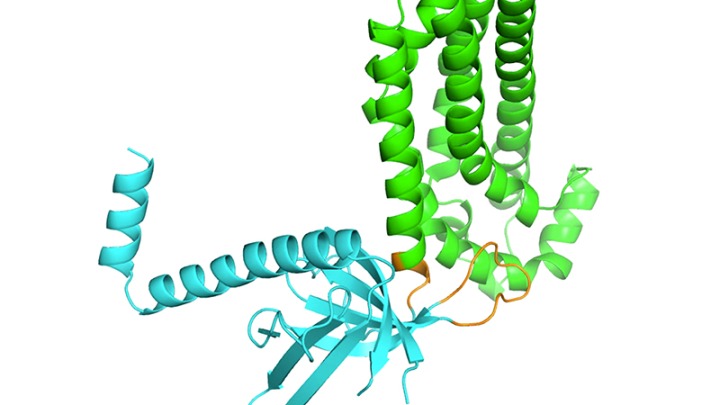
Solving a key protein’s structure offers new opportunities for targeting the most common form of eye cancer

A team of researchers has determined the shape of a key piece in the puzzle that leads to 90 percent of cases of uveal melanoma, the most common form of eye cancer in adults.
The findings, published Feb. 19 in Science Signaling, provide an entry point for scientists to develop molecules that could eventually help treat the disease.
In nearly all cases of uveal melanoma, a mutated form of a protein called Gq exploits a pathway the body uses during normal development. Normally, Gq has a built-in dam to slow down the river of signals flowing to Trio, another protein in the eye. But mutations to Gq remove this dam, causing continuous activation of Trio and jumpstarting the growth of cancer.
Trying to completely shut down Gq is not a viable option, because it is also heavily involved in essential bodily functions in the central nervous and cardiovascular systems.
“We don’t want to interfere with Gq due to its diverse roles in the body,” says study lead author Sumit Bandekar, a University of Michigan graduate student working at the U-M Life Sciences Institute. “So if we can’t target the protein that causes uveal melanoma, we can think about targeting the proteins that are activated by Gq — and Trio is the first protein it activates.”
Mouse models have shown that lowering the levels of Trio can decrease both the size and weight of uveal melanoma tumors, suggesting that targeting Trio might be an effective option for treating the human cancer.
“One of the big challenges in the field now is developing enough basic science knowledge about Trio to be able to target it,” explains Bandekar, who is pursuing a Ph.D. in medicinal chemistry at the U-M College of Pharmacy.
The research team — spanning the University of Michigan, Purdue University and the University of California, San Diego — has now revealed the structure of Trio in its closed, inactive state.
This new information will help them clear an early hurdle in the lengthy drug-discovery process. By solving the shape of the protein when it is inactive, scientists now have a better idea of what type of small molecules might be needed to help keep it locked in that position.
The researchers now plan to begin screening for such small molecules, with the hope of uncovering some that could eventually be developed into therapeutics for uveal melanoma.
“This cancer is really unique. Whereas most cancers are genetically very diverse, mutations in Gq accounts for close to 90 percent of uveal melanoma cases,” says Bandekar. “So we as scientists have a unique opportunity here — because if we find something, it will likely be helpful for almost all of the patients who suffer from this disease.”
The study’s senior author is John J.G. Tesmer, Ph.D., a former faculty member of the LSI, now at Purdue University.
Go to Article
Structure of the C-terminal guanine nucleotide exchange factor module of Trio in an autoinhibited conformation reveals its oncogenic potential, Science Signaling. DOI: 10.1126/scisignal.aav2449


